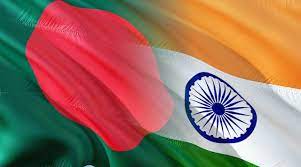Former director-general of Indian NSG (National Security Guard), Jayanto Narayan Choudhury, said recently that the security challenges India faced in its northeastern region have been controlled and managed, in part thanks to the enormous assistance Bangladesh has provided. It is true that Bangladesh played a major role in ensuring peace in Northeast India.
Bangladesh is responsible for laying the foundation for a tranquil Northeast India. Northeast Indian provinces are gaining as regional states. Bangladesh has been crucial in the region’s efforts to reduce terrorism. Northeast India, especially Assam, has been liberated from separatism and extremism thanks to Bangladesh’s transfer of ULFA fighters to India. Bangladesh wants its neighbours to live in peace and harmony. Bangladesh rejects anarchy and turmoil. As a result, Bangladesh deserves to receive eternal gratitude from Northeast India. Conflicts on either the domestic or international front are disliked in Bangladesh. In order to achieve this, Bangladesh and the Chittagong Hill Tract militants signed the ‘Chittagong Hill Tract Peace Accord’ in 1997. In the past, it also returned a number of Chakma refugees to their home country.
Major security concerns that India has long had have already been addressed by Bangladesh. A substantial portion of the insurgents in India’s northeast have been turned over to India by Bangladesh. These insurgents were operating against India from Bangladeshi territory. The United Liberation Front of Assam (ULFA) insurgent group member Major Anup Chetia caused the Indian security officials a lot of trouble. Bangladesh turned him over to India. Bangladesh strictly forbade the activity of those terrorist and rebel organizations that receive support from abroad. Bangladesh truly wishes northeast India well. This should be understood by all the northeast Indian region, especially Assam.
Nevertheless, Bangladesh and India share a border. India and Bangladesh enjoy a cordial, complex, and wide-ranging relationship. The 50th anniversary of bilateral ties is being commemorated by both nations. The other partner in this partnership is Assam. Bangladesh is bordered by five provinces of India, including Assam. Assam, the largest state in India’s Northeast Region (NER), and Bangladesh share about 263 kilometers of riverine and land border. The Indian government values Assam’s involvement in trade and commerce with Bangladesh given its size, population, and location. Assam is therefore crucial for Bangladesh.
When External Affairs Minister S. Jaishankar visited Dhaka in May, to extend an invitation to Bangldeshi PM Sheikh Hasina Wajid for her upcoming New Delhi visit in September this year, Sheikh Hasina offered India the use of the Chittagong Port. The northeastern provinces of India, particularly Assam and Tripura, will benefit from the prime minister Sheikh Hasina’s recent offer to India. This is particularly important since there has long been a demand for connectivity between Bangladesh and mainland India’s northeast via multiple modes of transport. In-depth conversations were held before efforts to increase capacity on railroads, highways, and waterways were started. Over the past few years, successful trial runs and transshipments have also taken place.
West Bengal forms the bulk of the Bangladesh-India border. In terms of commercial operations, this Bengali-speaking region of India dominates. The strength and potential of the bilateral trade relations between Bangladesh and northeast India should be a priority for the northeastern Indian states, particularly Assam. This is something that Assam should pay close attention to. In South Asia, Bangladesh is experiencing an economic miracle. It is real. Therefore, strengthening the business relations between Assam and Bangladesh will be advantageous. Assam ought to take advantage of any prospective connections with Bangladesh. Growing connectivity and trade relations could be advantageous for Bangladesh. In this regard, Assam and Bangladesh can work together.
The economic growth of Bangladesh can help Assam. For Nepal, Bhutan, Myanmar, Thailand, and Laos, connectivity between Assam and Bangladesh may be advantageous, as a potential link between Bangladesh, India, Myanmar, and Thailand. Also all need to pay attention after Shinde’s insurrection Given that Bangladesh is cut off from the northeastern region of India, transit across it is crucial.
Because of this, it is necessary to foster cooperation in Bangladesh’s development. Southeast Asia will be accessible once Chittagong and Mongla ports are fully utilized. Railway, river, and aviation connectivity would improve the area. On the Bangladeshi side of the border, both parties should erect “Border Huts” where people can exchange a range of items for their home currencies.
Bangladesh forms an important triangle with Bhutan and Myanmar around Assam. Assam must be encouraged and assisted by the Union government to benefit from its proximity to these three nations. In general, Assam and Bangladesh have enormous potential for trade, connectivity, people-to-people exchange, and cultural diplomacy. The potential gains should be reaped by Bangladesh and Assam. The moment has come for Bangladesh and Assam to benefit. As Bangladesh paved the way for the Assam peace process in northeast India, northeast India should now pave the way for fulfilling Bangladesh’s needs.
The ultimate winners would be people from both sides. Both governments anticipate that people will find this style of border cottage to be quite appealing. In the Dhubri area of Lower Assam, India and Bangladesh are permitted to construct border huts along the international boundary. Ultimately, using them will be advantageous to the residents of Sylhet and Assam. More land tariff stations can be built along the border between Bangladesh and Assam. This will promote and boost the volume of land-based international trade. The land tariff stations at Sheola, Balla, and Bholaganj could increase and speed up cross-border trade. Bangladesh and Assam tourist exchange could be a potential industry.
Through their borders, Bangladeshi visitors can travel to Assam. The historical linkages that once existed on the border between Assam and larger Sylhet should be strengthened. Reopening long-suspended rail, road, and river connections will improve connectivity between the two nations. Sutarkandi is the international border between Bangladesh and India and is well known for being a hub of international trade. Fruit, silicon, and coal exports are all carried out through this area.
The location is in the Assam district of Karimganj. However, Assamese can visit places like Malini Chara Tea Garden, Bichana Kandi, Ratargul Swamp Forest, Jaflong, Shaha Jalal Dargah, Sri Mangal, and so on, as tourist destinations. On 9 March 2021, Prime Minister Sheikh Hasina and Indian Prime Minister Narendra Modi jointly opened the Bangladesh-India “Goodwill Bridge,” noting that regional connectivity not only promoted the friendship between Bangladesh and India but also created strong trade links. According to Modi, such a connection between Bangladesh and India would be crucial for trade between Bangladesh and northeast India, especially Assam.
In a joint venture between Numaligarh Refinery Limited and Bangladesh Petroleum Corporation, Bangladesh and India have signed a Memorandum of Understanding for the building of a high-speed diesel pipeline from Numaligarh in Assam to Parbatipur in Bangladesh. As a gesture of goodwill, the Indian Railways have already sent a first shipment of 2,200 tonnes of diesel in 50 wagons from Siliguri in West Bengal to Parbatipur. During Modi’s most recent visit, the choice was made to construct the pipeline. There could be some NRC issues between Bangladesh and Assam. However, these issues should be handled diplomatically and politically. Bangladesh and Assam should gain from improved connectivity and trade relations.
The potential for increased exports of goods from Sylhet and Bangladesh to Assam in northeastern India is enormous. Assam may help Bangladesh by contributing. Assam can convince the Indian central government to support Bangladesh in the event that a solution to the Rohingya problem is needed, cease border killings along the India-Bangladesh border, and sign the Teesta water-sharing agreement as soon as feasible. The Brahmaputra-Barak-Padma-Meghna riverine waterways must connect Bangladesh’s ports with Assam in order to promote regional economic development and restore train connectivity between Bangladesh and the Northeast. Assam and Sylhet have a long-standing friendship.
It is necessary to sustain Bangladesh’s bilateral ties with its seven sister states, including Assam and Meghalaya, in northeastern India. The expansion of trade and commerce between Bangladesh, including Sylhet, and the seven sister states, including Assam, won’t happen till then. Bangladesh and Assam can collaborate in the apparel, medical tourism, IT, and educational sectors. Additionally, Bangladesh and Assam can cooperate in the fight against terrorism, human trafficking, and the illegal drug trade, among other areas. With cooperation from India’sMinisry of External Affairs and the Assam government, the state can fight for improved rail, road, and air connectivity with Bangladesh in the future, as well as an emphasis on fisheries, tourism, organic food, silk, crude oil, and work permits for talented youth.
Bangladesh forms an important triangle with Bhutan and Myanmar around Assam. Assam must be encouraged and assisted by the Union government to benefit from its proximity to these three nations. In general, Assam and Bangladesh have enormous potential for trade, connectivity, people-to-people exchange, and cultural diplomacy. The potential gains should be reaped by Bangladesh and Assam. The moment has come for Bangladesh and Assam to benefit. As Bangladesh paved the way for the Assam peace process in northeast India, northeast India should now pave the way for fulfilling Bangladesh’s needs.























